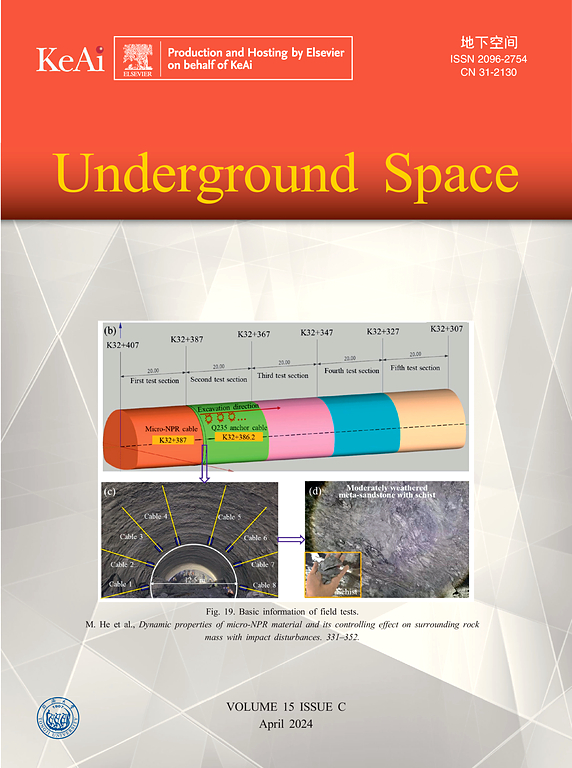非均匀逆断层作用下隧道力学响应分析的连续-离散耦合模型
IF 8.3
1区 工程技术
Q1 ENGINEERING, CIVIL
引用次数: 0
摘要
近几十年来,有许多关于隧道穿越活动断层的损坏案例的报道。跨断层隧道的力学响应和破坏机制已成为隧道工程领域的一个关键问题。建立了完整岩体、断裂带和隧道的连续-离散耦合模型。在该模型中,隧道和完整岩石被建模为连续介质,而断裂带被建模为离散介质。采用非均匀断层位移模拟逆断层作用下隧道穿越活动断层的力学响应和破坏模式。通过与2008年中国汶川地震龙池隧道的破坏观测以及模型试验的实验现象进行对比,验证了模拟结果。结果表明,所建立的耦合模型能较好地再现逆断层作用下隧道的破坏模式。此外,仿真结果与实验数据的高度一致性进一步证实了耦合模型的计算精度和可靠性。以湘芦山隧道为例,通过参数化分析,探讨了断层位移、断层宽度、断层倾角和断裂带岩体质量对跨断层隧道破坏模式的影响。该研究为逆断层隧道的抗震设防提供了有价值的参考。本文章由计算机程序翻译,如有差异,请以英文原文为准。
Continuum-discrete coupling model for mechanical response analysis of tunnels subjected to non-uniform reverse faulting
In recent decades, there have been numerous reports of damage cases involving tunnels crossing active faults. The mechanical response and failure mechanisms of cross-fault tunnels have become a key issue in the field of tunnel engineering. This study established a continuum-discrete coupling model comprising intact rock mass, fault zones, and tunnel. In this model, the tunnel and intact rock are modeled as continuous media, while the fault zone is modeled as a discrete medium. The non-uniform fault displacement is adopted to simulate the mechanical response and damage patterns of tunnels crossing active faults under reverse faulting. The simulation results are validated by comparison with the damage of Longchi tunnel observed from 2008 Wenchuan earthquake in China, as well as the experimental phenomenon from the model test. The results demonstrate that the proposed coupling model effectively reproduces the tunnel failure modes caused by reverse faulting. In addition, the high consistency between the simulation results and experimental data further confirms computational accuracy and reliability of the coupling model. A parametric analysis based on the Xianglushan tunnel in China is carried out to investigate the effects of fault displacements, fault widths, dip angles and fault zone rock mass qualities on damage patterns of crossing-fault tunnels. This study provides a valuable reference for seismic fortification of the tunnel crossing reverse faults.
求助全文
通过发布文献求助,成功后即可免费获取论文全文。
去求助
来源期刊

Underground Space
ENGINEERING, CIVIL-
CiteScore
10.20
自引率
14.10%
发文量
71
审稿时长
63 days
期刊介绍:
Underground Space is an open access international journal without article processing charges (APC) committed to serving as a scientific forum for researchers and practitioners in the field of underground engineering. The journal welcomes manuscripts that deal with original theories, methods, technologies, and important applications throughout the life-cycle of underground projects, including planning, design, operation and maintenance, disaster prevention, and demolition. The journal is particularly interested in manuscripts related to the latest development of smart underground engineering from the perspectives of resilience, resources saving, environmental friendliness, humanity, and artificial intelligence. The manuscripts are expected to have significant innovation and potential impact in the field of underground engineering, and should have clear association with or application in underground projects.
 求助内容:
求助内容: 应助结果提醒方式:
应助结果提醒方式:


